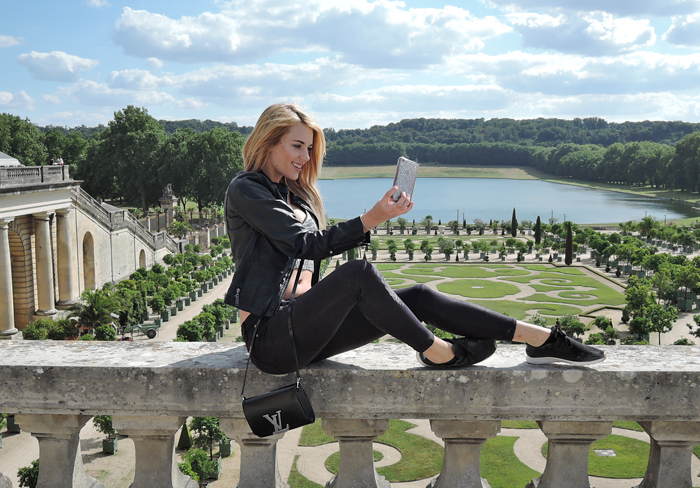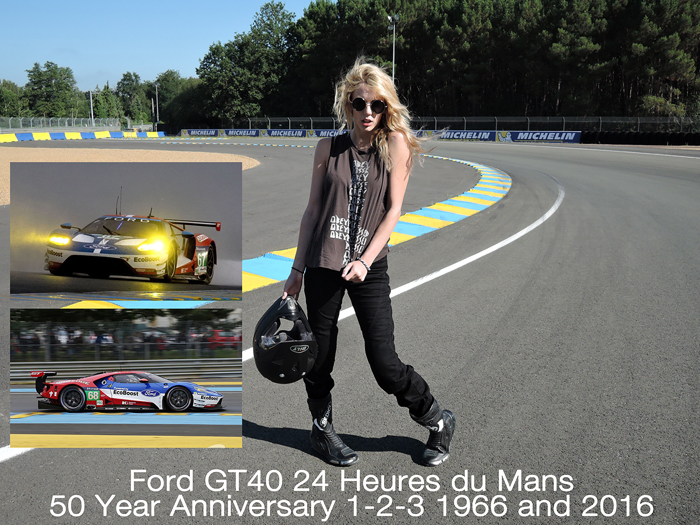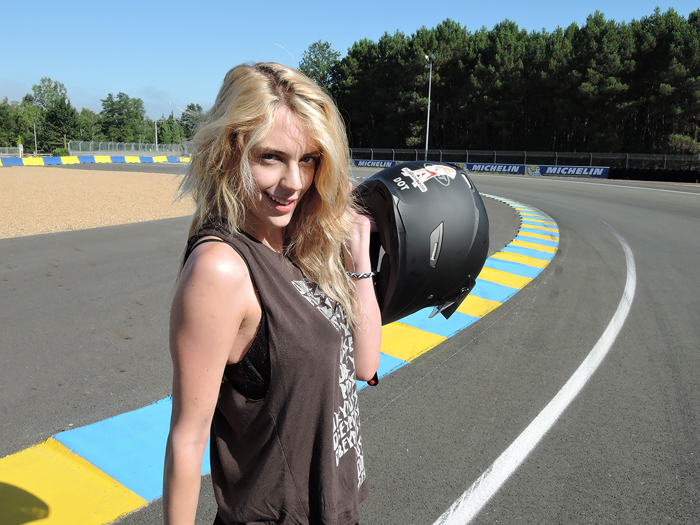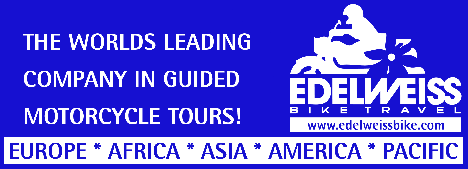|
Edelweiss Motorcycle Tour France - Paris to Omaha Beach Kaussie had just turned 20 the week before, and has been struggling with a lot of really serious issues in her life. This was essentially her first ever international vacation and trip to Europe. She is a real motorsports enthusiast, having grown up riding dirt bikes in the dessert and drifting cars on the street. This past July she served as one of our two SBK Fast date World Superbike grid and podium girls at Laguna Seca World Superbike, and as hostess at the 2106 LA Calendar Motorcycle Show. Look for her features next year in the next 2018 FastDates.com Calendars. I was excited to take Kaussie with me to France to share this motorcycle adventure.
This is the definition of an Edelweiss Bike Travel tour. And while they have a daunting Tour Catalog chock full of motorcycle tours taking place around the world from the far reaches of Africa and Asia, to Australia and America, every one of their European tours is on my bucket list. Especially when they partner their rides with motorcycle manufacturer like Ducati and Triumph, with a Start and End point at the company's factory for a visit or at a World Superbike or MotoGP round. Their available bikes include your choice among the top Touring and Sport Touring bikes from the top manufacturers. Edelweiss mails each tour participant a few weeks before the tour begins a comprehensve Tour nformation Package which includes a Michelin Road map of the county you will be riding, a Tour Guide Book ith each day's schedule and attractions to see, a Hotel Lis and Confirmed Rider List with thier contact Information. Then each morning of the tour ride, the group meets at 8:30 am after breakfast, suited up and ready to ride. There yu get last minute ride detaisl from the Tour Guide, and you can copy the days riding route to your personal Michelin map placed in the top of your motorcycle's supplied tank bag. A nice thing about any Edelweiss tour is you can ride at your own pace, or let the Tour Guide know you'ld like to leave the group to sight see on your own. If you get lost while following the group, the Tour Guides will always wait or come back to find you, otherwise you can plan to meet up again at the hotel that evening. If you break down or have a problem while riding alone, just phone the Tour Guide or the Hotel, and the Chase Truck will come back and pick you up. Kaustin grew up riding dirt bikes in the desert, but she had never been street riding before, so 10 days on the back of a BMW was going to be an all new experience for here. The week before we left on a trip, i took her down to a local Cycle Gear store and got her fully outfitted for head to toe in some pretty awesome house brand BILT riding gear that was impressively inexpensive. Everything including the sportbike boots, vented jacket with body armor and removable waterproof and thermal liners, Kevlar pants with knee pads, pants, and helmet were of really nice quality and only priced around $100 each,and armored sportbike gloves just $30. So her her entire riding gear set only set us back around $500. I liked the gear so much I bought a matching Men's Jacket and Kevlar Pants for me as well, which i also wore on the entire ride and just loved it more than my higher priced Alpine star gear I normally ride in. Pre Tour Arrival Day 1 - Chateau de Versailles Above, Kaustin taking selfies on the big veranda wall of the Palace of Versailles overlooking the Orange Gardens and one of the many lakes in the Palace Grounds. Pre Tour Day 2 - Paris Baby! Walking the streets of The Left Bank and Saint Germaine along the Seine River near Notre Dame Cathedral, their were hundreds interesting shops, restaurants, cafes and neat photo locations like the front of this Piano Bar that would open later in the evening. Double Decker bus tours are the best way to see the major sights of a big city like Paris within just a couple of hours, and the Bus Day Pass allows you to get off and on at interesting spots where you'd like to spend some time like here at the Eifel Tower. The Crew: We met up with our eight other Edelweiss tour members the next day for the start of our Edelweiss Paris to Omaha10-dy tour. Our group was made up of all Edelweiss tour veterans, three were couples also riding double but on on larger touring bikes. Most everyone was around 70 -80 years old and excited to be still riding. They were a diverse group of professional including a Vietnam veteran Plastic Surgeon who also worked the recent Haiti Disaster with Doctors Without Border, plus a Federal District Court Judge and his attorney wife, and a Donut King retired millionaire. We rode out of Versailles on beautiful high speed secondary roads across the rolling and wooded farm lands of western France, stopping in villages along the way for coffee breaks, or to stay for one or two nights in incredible 1700s country chateaus which served as hunting lodges for the kings of France back in the 1700 and 1800s. One exciting stop came at the legendary Le Mans race track where were toured the facilities and visited the race track's car museum and store.
Above left; Our first night on the road was spent in the city of Tours, where we took a walk after dinner to the local cathedral where the was an incredible projected 20-minute animated light show onto the front of the church choreographed to music during the summer months. It was a favorite for both locals and tourists alike. Tour Ride Day 2 - Tours to Angers (190km / 118m miles) Above right and below: Kaussie climbed over a castle wall and an iron spiked gate to get down into the dry moat of this castle. |
Morning coffee stop with Kaussie (foreground) and the group in the town of Chartes, at a cafe right in front of the glorious Cathedral Notre-Dame Chartes. Tour Ride Day 1 - Versailles to Tours (250km / 155 miles) "Please forgive her father for she hath sinned. "
And as you can see above from her post on Twitter, Kaustin really like our BMW R 1000 XR! :) My bike of choice on this tour was be the newly introduced BMW R1000 XR Sport Tourer, based on the potent BMW R 1000 RR Superbike. Normally I choose a Ducati Multistrada, which has been my favorite sport tourig bike the last 10 years, and I currently own the 1st generation 2010 Multistrda 1200 which I love. But with the introduction of the 2nd generation Multistada in 2015 and its newnew variabe cam Testastretta motor and Sky Active suspension, and having ridden the new model a copule of times, I just do not like the variable powerband of the motor nor the constantly changing suspension setting when riding fast. I think the the older model 1st Generation Multistrada 1200 is a better bike. So I wantd to try the new BMW XR beacuse it's more of a superbike, but with a much more comfortable touring setup and riding positions. And was I glad I did. I came away from this trip loving the new XR as the best performing and handling sport toring bike on the market today. I can't wait to repace my old Multistrada 1200 with the new BMW R1000 XR! Dining with Kings The Palace of Chombard was our lunch stop on Day One. This adjacent outdoor dining area with different food vendors, and a great choice of food, and everyone a chance to relax for an hour before getting back in the saddle. We had the choice to take tours of the beautiful palaces and castles we stopped by, and some of the couples did break off from the group to do so, but most of us were content to follow the Edelweiss tour guides and relax at the coffee and lunch stops. Optional RideDay 2 - LeMans Baby! (275km / 171 miles) Kaustin checks out one of the two "Kinks" or chicanes built on the Mulsane Straight in 1990 to slow down the top speeds of the World Endurance Sports cars which were reaching over 250mph. The circuit on which the 24 Hours of Le Mans is run is named the Circuit de la Sarthe, after the department that Le Mans is within. It consists of both a permanent track and public roads that are temporarily closed for the race. Since 1923, the track has been extensively modified, mostly for safety reasons, and now is 13.629 km in length. Although it initially entered through the town of Le Mans, the track was cut short in order to better protect spectators. This led to the creation of the Dunlop Curve and Tertre Rouge corners before rejoining the old circuit on the Mulsanne. Another major change was on the Mulsanne itself in 1990, when the FIA decreed that it would no longer sanction any circuit that had a straight longer than 2 miles. This led to the addition of two chicanes, reducing the time that the cars spent travelling at very high speeds on the old 6 km long straight. The addition of the chicanes was another safety precaution after the WM P88-Peugeot of French driver Roger Dorchy had been timed at 405 km/h (252 mph) during the 1988 race. Due to the shorter length of the straights, thanks to this chicane and one other a mile down the road, top speeds at Le Mans are now generally around 205 mph (330 km/h). This is the First Chicane turn-in tire barrier and the 90 /180 / 90 -degree turn that has seen over the years so many epic trips through the gravel trap, crashes, and fatalities. Kaustin gets it sideways on the tire barriers through the First Chicane at Le Mans VIP Grand Stands in the Front Straightway at Le Mans! Tour Ride Day 3 - Carnac (250 km / 155 miles)
Tour Ride Day 4, Rest Day 5 - Carnac to Brest (340 km / 211 miles) |
Ride Day 7 Stop - Le Mont-Saint-Michel The island has held strategic fortifications since ancient times and since the 8th century AD has been the seat of the monastery from which it draws its name. The structural composition of the town exemplifies the feudal society that constructed it: on top, God, the abbey and monastery; below, the great halls; then stores and housing; and at the bottom, outside the walls, houses for fishermen and farmers. Its unique position — on an island just 600 metres from land — made it accessible at low tide to the many pilgrims to its abbey, but defensible as an incoming tide stranded, drove off, or drowned would-be assailants. The Mont remained unconquered during the Hundred Years' War; a small garrison fended off a full attack by the English in 1433. The reverse benefits of its natural defence were not lost on Louis XI, who turned the Mont into a prison. Thereafter the abbey began to be used more regularly as a jail during the Ancien Régime. One of France's most recognizable landmarks, visited by more than 3 million people each year, Mont Saint-Michel and its bay are on the UNESCO list of World Heritage Sites.[3] Over 60 buildings within the commune are protected in France as monuments historiques. On Day Three we reached the western coat of France on the Atlantic Ocean, stayed in beautiful seaside villages next to history castles and light houses, had roadside lunch picnics. We then reached the historic World War Two cities like Saint-Nazairet,below, and D-Day beaches of Ponte du Hoc, Omaha, Sward and Gold and visited the US Military cemetery which brought me to tears. My father, then US Army Air Corp Captain Jim Gianatsis was a B26 Marauder bomber pilot during World War II, stationed in England with with the 386th Bomber Group. It was his Group that help take out the German submarine bases along the Atlantic coasts,costal defences and supply routes, the big guns on the bluffs at Ponte du Hoc overlooking the Normandy beaches in the weeks before June 6th, and to open up the beaches for the Allied Invasion on D-day morning. This trip was to see where he fought and left his mark to free Europe from the Nazis. It was truly an educational, moving and important moment in my life. The German U-Boat fleet which fought in the Battle of the Atlantic during the Second World War operated out of a number of bases on the French Atlantic coast which included Saint Nazaire. Immortalized in the film Das Boot, casualties among the Kriegsmarine who operated the U-Boats were high: a staggering 3 in 4 of the U-Boat crews became casualties in WW2. Another day's ride stop over for lunch included one of the German Submarine Base pens at Saint-Nazairet, protecting the German submarine flaws which attacked Allied shipping in the Atlantic. A number of such submarine bases were built by the Germans using forced laborers, some 15,000 workers at each location working around the clock 24/7 to build each base in less than 12 months. The reinforced concrete walls and roofs of the pens were some 7 meters / 22 feet thick to be indestructible to Allied bombings. http://web.mst.edu/~rogersda/umrcourses/ge342/U-Boat%20Pens%20and%20Bases-revised.pdf Before the Second World War, Saint-Nazaire was one of the largest harbours of the Atlantic coast of France. During the Battle of France, the German Army arrived in Saint Nazaire in June 1940. The harbour was immediately used for submarine operations, with U-46 arriving as soon as 29 September 1940. In December, a mission of the Organisation Todt (Oberbauleitung Süd) inspected the harbour to study the possibilities to build a submarine base invulnerable to air bombing from England. Work soon began under the supervision of engineer Probst. The selected space was that of the docks and buildings of the Compagnie Générale Transatlantique, that were rased. Building began in February 1941 with pens 6,7 and 8, completed in June 1941. From July 1941 to January 1942, pens 9 through 14 were built; and between February to June 1942, pens 1 through 5. Work was eventually completed by the building of a tower. German submarines captured in the submarine pans at Saint-Nazaire. Between late 1943 and early 1944, a fortified lock was built to protect submarines during their transfer from the Loire river and the pens. The lock is 155 metre long, 25 metre wide, and 14 metre high; the roof features anti-aircraft armament. The Saint-Nazaire dock was the target of Operation Chariot, a British commando raid in 1942. The attack, known as the St Nazaire Raid, successfully destroyed the adjacent dry-dock by ramming an explosive-filled destroyer into it, but the U-boat pens were not targeted. The U-Boat Pens at Saint Nazaire are typical of the ‘Nazi Megastructures’ to be found at sites like this. The U-Boat pens at Saint Nazaire were built between 1941-42 and came under attack during the Commando Operation here as part of Operation Chariot, although they were not damaged. In fact constant aerial bombardment did very little damage to them but completely destroyed Saint Nazaire with more than 500 civilians being killed here during the bombing., the entire city of Saint-Nazaire was also bombed to the ground so their was no logistical support for the troops and workers at the port. After the war the pens proved impossible to tear down, so they remain in place today. The Salt Farms! Kaussie and I spent the afternoon having lunch and shopping and in the oceasode resort village of Carna where we spent 2 nights at the Chemin du Tumuls resort hotel. Sunset with Kaussie on top of the mountainwith a small church, beside our hotel at Carna. Photographer, writer and favorite model on an awesome bike trip. And we got the T-shirts to prove it!
This coffee stop on our our last day and ride back to Versailles, was in a town with another beautiful Cathedral, this one showing evidence of the war with multiple bullet strikes on the right side below the slotted windows, possibly where German snipers were shooting from.
Tour Riding Day 6: Brest - Saint-Malo (390 km / 242 miles)
Another day, another castle. Gourmet dinners in historic Chateau Hotels each night were normal. Here I propose a toast to our tour group. |
The bombed out fortified German Big Gun Enplacemnts on Ponte du Hoc, overlooking the English Channel Invasion Route and the D-Day beaches of Normandy Ponte du Hoc and the 386th Bomber Group The Pont du Hoc location was bombed in April 1944 by my father, B26 bomber pilot Capt. James Gianatsis and his 386th Bomber Group consisting of low level precision bombing B26 Marauders. Bombing damage was extensove after their strikes (shown above), the Germans removed the surviving 155mm guns and hid them in farm field hedge rows a distnce away. During preparation for Operation Overlord it was determined that Pointe du Hoc should still be attacked by ground forces, to prevent the Germans using the bombed out gun casemates for observation. The U.S. 2nd and 5th Ranger Battalions were given the task of assaulting the strong point early on D-Day morning . Elements of the 2nd Battalion went in to attack Pointe du Hoc, but delays meant the remainder of the 2nd Battalion and the complete 5th Battalion landed at Omaha Beach as their secondary landing position. Though the Germans had removed the main armament from Ponte du Hoc, the Normandy beachheads were shelled from the nearby Maisy battery. The rediscovery of the battery at Maisy has shown that it was responsible for firing on the Allied beach heads until June 9, 1944. The 386th Bomber group's destruction of the heavy gun emplacements atPonte du Hoc defending the Normandy coastlines,opening the door for the Allied D-Day invasion of June 6th 1944. My father, pilot Captain James Gianatsis (standing left) and the 4 member crew of his B26 Marauder "Blazing Heat". Note under his name painted under the left cockpit window the 105 bombs signifying the number of missions flown and counting..., During the months of April, May and early June 1944, the 386th Group attacked a number of costal guns and other coastal defences including Ponte du Hoc. There was seemingly no system to these attacks but later became known that this was the design of Higher Command - that for every attack on prime invasion targets like Pont du Hoc, there were to be two attacks in other areas as a security screen. The heaviest bombs were carried in these attacks and over the period of time some 1584 tons were dropped by 772 aircraft of the Group. The photo above shows Ponte du Hoc at high tide where it would be impossible for the Allies to land on the small rocky beach below and scale the cliffs, so D-day was timed for 6:30 am low tide for the beach assaults as the painting below depicts. Pointe du Hoc lies 4 mi (6.4 am) west of the center of Omaha Beach. As part of the Atlantic Wall fortifications, the prominent cliff top location was fortified by the Germans. The battery was initially built in 1943 to house six captured French First World War vintage GPF 155mm K418(f) guns positioned in open concrete gun pits. The battery was occupied by the 2nd Battery of Army Coastal Artillery Regiment 1260 (2/HKAA.1260).[4] To defend the promontory from attack, elements of the 352nd Infantry Division were stationed at the battery. To provide increased defensive capability, the Germans began to improve the defenses of the battery in the spring of 1944, with enclosed H671 concrete casemates. The plan was to build six casemates but two were unfinished when the location was attacked. The casemates were built over and in front of the circular gun pits, which housed the 155mm guns. Also built was a H636 observation bunker and L409a mounts for 20mm Flak 30 anti-aircraft guns. The 155mm guns would have threatened the Allied landings on Omaha and Utah beaches when finished, risking heavy casualties to the landing forces. The location was bombed in April 1944, after which the Germans removed the 155mm guns. During preparation for Operation Overlord it was determined that Pointe du Hoc should be attacked by ground forces, to prevent the Germans using the casemates for observation. The U.S. 2nd and 5th Ranger Battalions were given the task of assaulting the strong point early on D-Day. Elements of the 2nd Battalion went in to attack Pointe du Hoc but delays meant the remainder of the 2nd Battalion and the complete 5th Battalion landed at Omaha Beach as their secondary landing position.
The assault force was carried in ten landing craft with another two carrying supplies and four DUKW amphibious trucks carrying the 100 ft (30 m) ladders - requisitioned from the London Fire Brigade. One of the landing craft carrying troops sank and all but one of its occupants drowned, another was swamped. One supply craft sank and the other put the stores overboard to stay afloat. German fire sank one of the DUKWs. Once within a mile of the shore, German mortars and machine guns fired on the craft. These initial setbacks resulted in a 40-minute delay in landing at the base of the cliffs, but British landing craft carrying the Rangers finally reached the base of the cliffs at 7:10am with approximately half the force it started out with. The landing craft were fitted with rocket launchers to fire grapnels and ropes up the cliffs. As the Rangers scaled the cliffs the Allied destroyers USS Satterlee and HMS Talybont provided them with fire support and ensured that the German defenders above could not fire down on the assaulting troops. The cliffs actually proved to be higher than the ladders could reach.
Actual photos of the US Army Rangers at Ponte de Hoc in the B26 bombed out gun emplacements, and below, climbing their rocket launched grappling ropes up the cliffs. The original plans had also called for an additional, larger Ranger force of eight companies (Companies A and B of the 2nd Ranger Battalion and the entire 5th Ranger Battalion) to follow the first attack, if successful. Flares from the cliff tops were to signal this second wave to join the attack, but because of the delayed landing, the signal came too late, and the other Rangers landed on Omaha instead of Pointe du Hoc. The added impetus these 500 plus Rangers provided on the stalled Omaha Beach landing has been conjectured to have averted a disastrous failure there, since they carried the assault beyond the beach, into the overlooking bluffs and outflanked the German defenses.
The force at the top of the cliffs also found that their radios were ineffective. Upon reaching the fortifications, most of the Rangers learned for the first time that the main objective of the assault, the artillery battery, had been removed. The Rangers regrouped at the top of the cliffs, and a small patrol went off in search of the guns. Two different patrols found five of the six guns nearby (the sixth was being fixed elsewhere) and destroyed their firing mechanisms with thermite grenades. After our Edelweiss Tour Group left Normandy Beach and the American Memorial, we made one more stop at nearby Pegasus Bridge, a bascule bridge (a type of movable bridge), that was built in 1934, that crossed the Caen Canal, between Caen and Ouistreham, in Normandy, France. Also known as the Bénouville Bridge after the neighbouring village, it was,along with the nearby Ranville Bridge over the river Orne, a major objective of the British airborne troops during Operation Deadstick, part of Operation Tonga in the opening minutes of the Allied invasion of Normandy on 6 June 1944 during the Second World War. A unit of Glider infantry of the British 6th Airborne Division, commanded by Major John Howard, was to land, take the bridges intact and hold them until relieved. The successful taking of the bridges played an important role in limiting the effectiveness of a German counter-attack in the days and weeks following the Normandy invasion. On the night of 5 June 1944, a force of 181 men, led by Major John Howard, took off from RAF Tarrant Rushton in Dorset, southern England in six Horsa gliders to capture Pegasus Bridge, and also "Horsa Bridge", a few hundred yards to the east, over the Orne River. The force was composed of D Company (reinforced with two platoons of B Company), 2nd Battalion, Oxford and Bucks Light Infantry; 20 sappers of the Royal Engineers of 249 Field Company (Airborne); and men of the Glider Pilot Regiment. The object of this action was to prevent German armour from crossing the bridges and attacking the eastern flank of the landings at Sword Beach. Five of the Ox and Bucks's gliders landed as close as 47 yards from their objectives from 16 minutes past midnight. The attackers poured out of their battered gliders, completely surprising the German defenders, and took the bridges within 10 minutes. They lost two men in the process, Lieutenant Den Brotheridge and Lance corporal Fred Greenhalgh. Greenhalgh drowned in a nearby pond when his glider landed. Lieutenant Brotheridge was killed crossing the bridge in the first minutes of the assault and thus became the first member of the invading Allied armies to die as a result of enemy fire on D-Day. One glider, assigned to the capture of the river bridge, landed at the bridge over the River Dives, some 7 miles off. Most of the soldiers in this glider moved through German lines towards the village of Ranville where they eventually re-joined the British forces. The Ox and Bucks were reinforced half-an-hour after the landings by Lieutenant Colonel Pine-Coffin's 7th Parachute Battalion, and linked up with the beach landing forces with the arrival of Lord Lovat's Commandos.[2] One of the members of the 7th Battalion reinforcements was Captain Richard Todd, a young actor, who would, nearly two decades later, play Major Howard in the film The Longest Day In 1944 it was renamed Pegasus Bridge in honour of the operation. The name is derived from the shoulder emblem worn by the British airborne forces, which is the flying horse Pegasus. Tour guide Thomas meets us with the Tour Van for a picnic lunch on two of the tour days, this one in a beach front park, the other on Omaha Beach. On most Edelweiss tours like ours, we'll come upon our Edelweiss chase van, like here, where the guide has prepared us an excellent lunch, complete with tables and chairs, plates and silverware. Each day the van also picks up and takes our personal luggage from one hotel to the next, and the guide has it placed in our room in time for our arrival for a great day of riding!
|
In many ways the mission was a milk run for the Group. No heavy flak was seen although considerable light flak was encountered, only two aircraft received light damage and all returned safely to base. The mission execution was something else. The briefing had called for bombings at 12.000 feet, normal altitude for the Marauder. They had also been briefed if the weather was bad they cloud bomb as low as 1500 feet. Actually the formations bombed between 2,000 and 6,000 feet depending on the height of the base clouds. The assigned targets were all well hit which was a tribute to the excellence of the combat crews and of the target material which had been provided for them. - From the book "The Story of the Crusaders The 386th Bomb Group"
Normandy, France, D-Day June 6th 1944 - Within one hour 175,000 soldiers and 20,000 vehicles land on the coast of Normandy, making “Operation Overlord” the largest military operation in history. The Battle of Normandy raged on for 76 days, claimed 500,000 lives and caused widespread destruction. Some cities, like Le Havre, were completely wiped out. It was the beginning of the liberation of Europe, a year later World War II was over. Above: Today, the Beaches of Normandy show no evidence of the D-Day Invasion which took place here some 70 years ago. Those bluffs in the background are Ponte de Hoc were the German costal guns had been. Our Edelweiss tour group stopped here for a picnic lunch set out by the Edelweiss guides. The American War Cemetary Memorial at Normandy Beach. This coffee stop on our our last day and ride back to Versailles, was in a town with another beautiful Cathedral, this one showing evidence of the war with multiple bullet strikes on the right side below the slotted windows, possibly where German snipers were shooting from. In closing, my riding partner, model and good friend Kaussie is an incredibly beautiful person inside and out. Love you Kaussie. And how would i sum up this Edelweiss trip From Paris to Omaha? If you're a hard core rider looking for challenging roads, this isn't for you. But if you've never been to Western France, want to share in the rich culture and history, especially when it comes to America's tole in World war II and D-day, this is a must. I have to tell you there were so many more places, pictures and stories from this trip that I just didn't have the space to put here. Which will give you much more to discover should you take the trip. This is just to wet your appetite. Bon Jour et Bon Voyage! Tour Riding Day 9: Honfleur - Versailles (310 km / 193 miles) Don't wait! Make up your own "Once in a Lifetime Trip" Experience on an Edelweiss World Tour of you choice now. You'll find more exciting FastDates.com Calendar adventures, our Calendar photo shoots, the Bikes and the Calendar Kittens in the annual FAST Calendar Yearbooks avaialble to rad and download in Members Corner
There's More FastDates.com Calendar Adventures! Jim and Kaustin at 2016 Laguna Seca World Superbike • The LA Calendar Motorcycle Show DRE and Troy Bayliss Race Schools Info: http://www.Ducati.com • http://TroyBaylissExperience.com.au Also See Our Other Edelweiss Tours! Edelweiss Ducati Imola Italy Tour:
|





























































